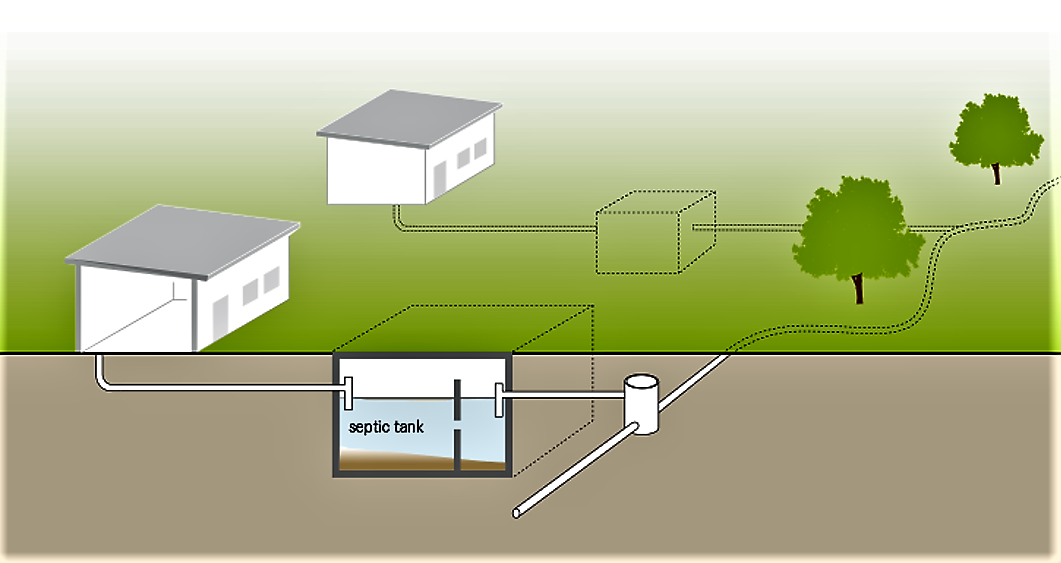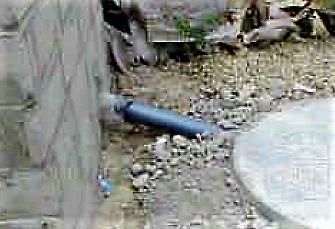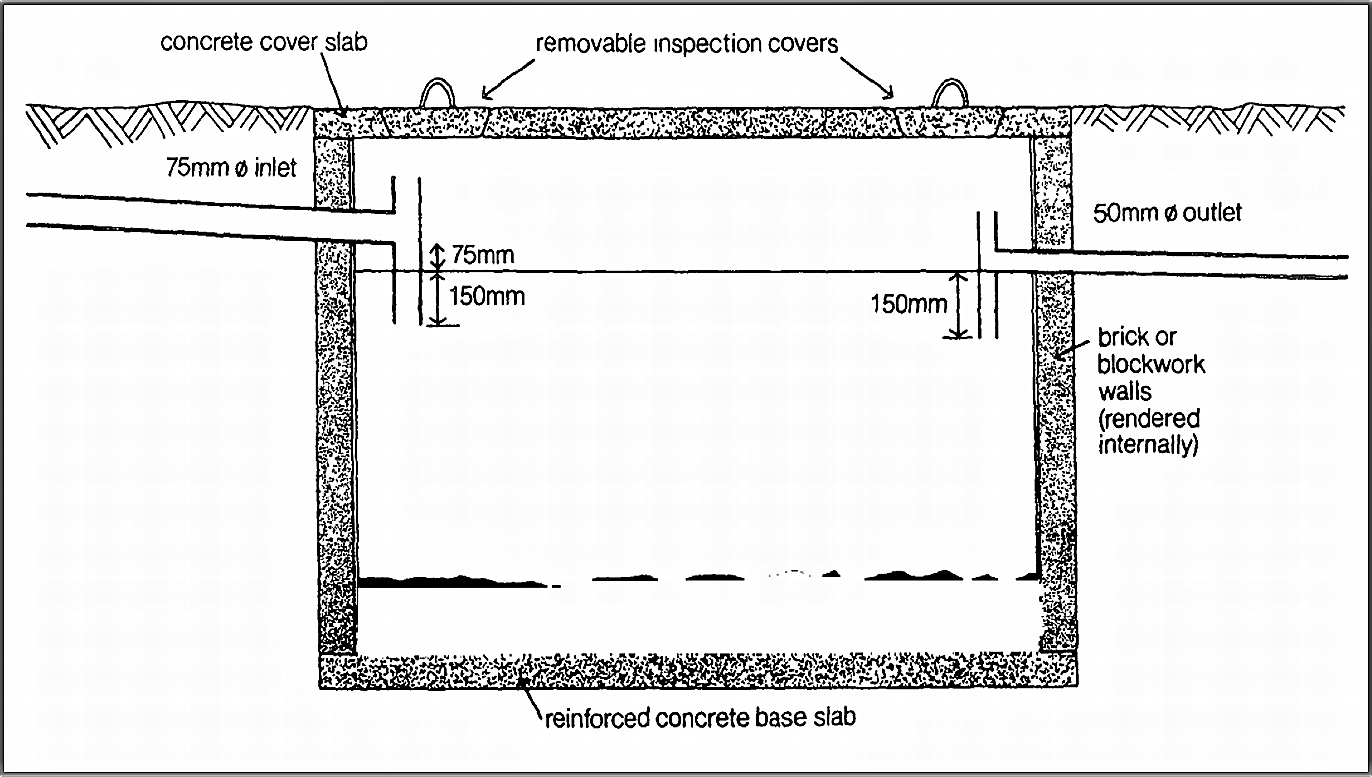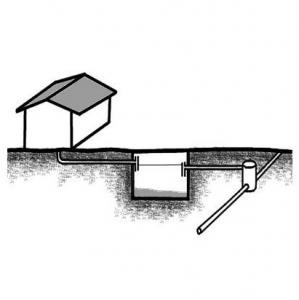Executive Summary
A solids-free sewer is a network of small-diameter pipes that transports pre-treated and solids-free wastewater (such as septic tank or biogas settler effluent) to a treatment facility for further treatment or to a discharge point. As solids are removed, the diameter of the sewers can be much smaller than for conventional sewers . It can be installed at a shallow depth and does not require a minimum wastewater flow or slope to function. Thus, significant lower construction costs are required than for conventional sewers. Solids-free sewers can be built for new areas or where soil infiltration of septic tanks effluents (e.g. via leach fields) is not appropriate anymore (i.e. densely populated areas, clogging of sub-surface). Although solids-free sewers require a constant supply of water, less water is needed compared to conventional sewers because self-cleansing velocities are not required.
| In | Out |
|---|---|
Blackwater, Greywater, Brownwater, Urine or Yellowwater, Non-biodegradable Wastewater |
Blackwater, Non-biodegradable Wastewater |
Introduction
Solids-free sewer systems are similar to conventional sewer systems, with the difference that the wastewater is pre-settled and solids removed. Solids-free sewers are also referred to as settled, small-bore, small-diameter, variable-grade gravity, or septic tank effluent gravity sewers. A precondition for solids-free sewers is efficient primary treatment at the household level.
An interceptor, typically a single-chamber Septic Tank , biogas settler or anaerobic baffled reactor) , captures settleable particles that could clog small pipes. The solids interceptor also functions to attenuate peak discharges. Solids-free sewers bring the pretreated wastewater to a further treatment (e.g. free-surface or horizontal and vertical subsurface flow wetlands, waste stabilisation ponds, etc.) or to a discharge point connected to another sewer system.
Because there is little risk of depositions and clogging, solids-free sewers do not have to be self-cleansing, i.e., no minimum flow velocity or tractive tension (see also vacuum sewers or pressurised sewers) is needed. They require few inspection points, can have inflective gradients (i.e., negative slopes) and follow the topography. Due to the simplified design, solids-free sewers can be built cheaper. Nevertheless, expert design and construction supervision is essential and repairs and removal of blockages may be required more frequently than for a conventional gravity sewer.
Moreover, effluent and sludge (from interceptors) require secondary treatment and/or appropriate discharge (e.g. settling and thickening, drying and mineralization, non-planted filters, mechanical dewatering, composting, further anaerobic digestion at large scale). Small-bore sewers also require a certain level of responsibility of users, because maintenance is high due to the high risk of clogging in case of bad operation and maintenance (e.g. clandestine discharge of greywater etc. that has not been pre-settled).
When the sewer roughly follows the ground contours, the flow is allowed to vary between open channel and pressure (full-bore) flow.

Design Considerations
A precondition for solids-free sewer networks is an efficient pre-treatment at the household level. If the interceptors (e.g. septic tank, biogas settler or anaerobic baffled rector) are correctly designed and operated, this type of sewer does not require self-cleansing velocities or minimum slopes. Even inflective gradients are possible, as long as the downstream end of the sewer is lower than the upstream end. Solids-free sewers do not have to be installed on a uniform gradient with a straight alignment between inspection points. The alignment may curve to avoid obstacles, allowing for greater construction tolerance.
When the sewer roughly follows the ground contours, the flow in the sewer is allowed to vary between open channel flow and pressure flow. However, care should be taken with negative slopes as they may lead to surging above the ground level during peak flows. Inspection points (see picture) should be provided at major connection points or when the size of the pipe changes. At high points in sections with pressure flow, the pipes must be ventilated. A minimum diameter of 75 mm is required to facilitate cleaning. When choosing a pipe diameter (at least 75 mm), the depth of water in the pipe during peak flow within each section must be less than the diameter of the pipe.
In sections where there is pressure flow, the invert of any interceptor tank outlet must be higher than the hydraulic head within the sewer just prior to the point of connection. Otherwise, the liquid will backflow into the tank. If this condition is not met, then either select the next larger pipe diameter for the sewer or increase the depth at which the sewer is laid.

Expensive manholes are not needed because access for mechanical cleaning equipment is not necessary. Cleanouts or flushing points are sufficient and are installed at upstream ends, high points, intersections, or major changes in direction or pipe size. Compared to manholes, cleanouts can be more tightly sealed to prevent stormwater from entering. Stormwater must be excluded as it could exceed pipe capacity and lead to blockages due to grit depositions. Ideally, there should not be any storm- and groundwater in the sewers, but, in practice, some imperfectly sealed pipe joints must be expected. Estimates of groundwater infiltration and stormwater inflow must, therefore, be made when designing the system. The use of PVC pipes can minimize the risk of leakages.
Pumping may be necessary where the elevation differences do not permit gravity flow. The operation of a pressure sewer, however, relies on a reliable source of electricity.
Health Aspects/Acceptance
If well constructed and maintained, sewers are a safe and hygienic means of transporting wastewater. Users must be well trained regarding the health risks associated with removing blockages and maintaining interceptor tanks.
Costs Considerations
Due to the simplified design, solids-free sewers can be built for 20% to 50% less costs than conventional sewerage. However, expert design and construction supervision is essential. Moreover, repairs and removal of blockages may be required more frequently than for a conventional gravity sewer. Also the costs for emptying the pre-settling unit (e.g. septic tank, biogas settler) must be considered.
Operation & Maintenance
Trained and responsible users are essential to avoid clogging by trash and other solids. Regular desludging and emptying (see human powered or motorised emptying and transport) of the pre-settling units such as septic tanks , biogas settler , is critical to ensure optimal performance of the sewer. Periodic flushing of the pipes is recommended to insure against blockages.
The risk of pipe clogging is low if the sewers are well operated and maintained, however, some maintenance is required periodically. Regardless of performance, the sewers should be flushed once a year.

Special precautions should be taken to prevent illegal connections, since it is likely that interceptors would not be installed and solids would enter the system.
The sewerage authority, a private contractor or users committee should be responsible for the management of the system, particularly, to ensure that the interceptors are regularly desludged and to prevent illegal connections.
This type of sewer is best suited to medium-density (peri-) urban areas and less appropriate in low-density or rural settings. It is most appropriate where there is no space for a Leach Field or a soak pit , or where effluents cannot otherwise be disposed of onsite (e.g., due to low infiltration capacity or high groundwater). It is also suitable where there is undulating terrain or rocky soil. A solids-free sewer can be connected to existing septic tanks where infiltration is no longer appropriate (e.g., due to increased housing density and/or water use).
As opposed to a Simplified Sewer a solids-free sewer can also be used where domestic water consumption is limited as it requires a constant supply of water, although less water is needed compared to conventional sewers .
This technology is a flexible option that can be easily extended as the population grows. Because of shallow excavations and the use of fewer materials, it can be built at considerably lower cost than a Conventional Gravity Sewer.
Solids-free sewer systems should be installed in areas with a high willingness to pay (for the operation and maintenance) and with locally available expertise and resources. Furthermore, users should receive some basic training in order to prevent clandestine discharge of non-pre-settled wastewater into the sewers. Moreover, responsibilities of sewerage authority, a private contractor or users committee for the regular control and management of the systems have to be clear.
Innovative and Low-Cost Technologies Utilized in Sewerage
From the original wooden pipes from the 1800's to modern day systems, sewer systems have been a public health concern in urban and rural areas. The report gives technical and design specifications on the new modifications available in sewer systems, including hydraulic characteristics, construction costs, operation and maintenance, and services and infrastructure support.
AZEVEDO NETTO, J REID, R. (1992): Innovative and Low-Cost Technologies Utilized in Sewerage. (= Technical Series No. 29 / PAHO Environmental Health Program ). Washington, D.C.: Pan American Health OrganizationWet or Dry Ecological Sanitation in Periurban Areas
Small and Decentralized Wastewater Management Systems
Decentralised wastewater management presents a comprehensive approach to the design of both conventional and innovative systems for the treatment and disposal of wastewater or the reuse of treaded effluent. Smaller treatment plants, which are the concern of most new engineers, are the primary focus of this book.
CRITES, R. TCHOBANOGLOUS, G. (1998): Small and Decentralized Wastewater Management Systems. New York: The McGraw-Hill Companies IncLow-cost Urban Sanitation
This book covers the public health, technical, socioeconomic, sociocultural and institutional aspects of sanitation in towns and cities of developing countries. The text features excreta-related diseases and the use of sanitation to reduce their transmission. The sanitation technologies covered in detail are VIP latrines, pour-flush toilets, septic tanks, settled sewerage and simplified sewerage, with additional chapters on sullage disposal, pit emptying, and sewage treatment and reuse. Sociocultural constraints on sanitation systems and their socioeconomic costing are described, together with hygiene education, which is essential in order to achieve maximum benefits to health. The text also explains how to choose the most appropriate sanitation option for a given low-income community. Finally, institutional aspects are reviewed, including effective sanitation programme planning, monitoring and evaluation.
MARA, D. (1996): Low-cost Urban Sanitation. United Kingdom: WileyLow-cost Sewerage
This article reviews low-cost sewerage options, their potential and their limitations. It also provides guidance on how to choose the most appropriate option, and gives examples of their successful application.
MARA, D. (1996): Low-cost Sewerage. Leeds: University of Leeds URL [Accessed: 28.05.2019]The Design of Small Bore Sewer Systems
This technical document contains information about small bore sewer systems.
OTIS, R. MARA, D. (1985): The Design of Small Bore Sewer Systems. Washington, DC: The International Bank for Reconstruction and Development/The World Bank URL [Accessed: 30.05.2019]Compendium of Sanitation Systems and Technologies. 2nd Revised Edition
This compendium gives a systematic overview on different sanitation systems and technologies and describes a wide range of available low-cost sanitation technologies.
TILLEY, E., ULRICH L., LÜTHI, C., REYMOND P. and ZURBRÜGG C. (2014): Compendium of Sanitation Systems and Technologies. 2nd Revised Edition. Duebendorf, Switzerland: Swiss Federal Institute of Aquatic Science and Technology (Eawag) URL [Accessed: 03.05.2023] PDFCompendium of Sanitation Systems and Technologies (Arabic)
This is the Arabic version of the Compendium of Sanitation Systems and Technologies. The Compendium gives a systematic overview on different sanitation systems and technologies and describes a wide range of available low-cost sanitation technologies.
TILLEY, E. ULRICH, L. LUETHI, C. REYMOND, P. SCHERTENLEIB, R. ZURBRUEGG, C. (2014): Compendium of Sanitation Systems and Technologies (Arabic). 2nd Revised Edition. Duebendorf, Switzerland: Swiss Federal Institute of Aquatic Science and Technology (Eawag) PDFLinking Technology Choice with Operation and Maintenance in the context of community water supply and sanitation. A reference Document for Planners and Project Staff
This document is addressed to planners and staff of water supply and sanitation projects on household and community level. The reader is guided through the main steps of informed choices regarding the main proven technologies for water supply, purification and water treatment at household and community level. Each technology is described in a small factsheet, regarding its functioning, actors and their roles, the main operation and maintenance (O&M) requirements and problems, which can occur.
BRIKKE, F. BREDERO, M. (2003): Linking Technology Choice with Operation and Maintenance in the context of community water supply and sanitation. A reference Document for Planners and Project Staff. Geneva: World Health Organization and IRC Water and Sanitation Centre URL [Accessed: 03.06.2018] PDFWater Pollution Control - A Guide to the Use of Water Quality Management Principles
This document is rather old, but its publication was a milestone as it demonstrates WSSCCs capacity to bring together water and sanitation professionals from industrialised and developing countries to formulate practical guidance on a key issue of the day. Mainly regulatory, financial and technical aspects are discussed and illustrated with an extensive collection of case studies from the developing world.
HELMER, R. ; HESPANHOL, I. (1997): Water Pollution Control - A Guide to the Use of Water Quality Management Principles. World Health Organization (WHO), Water Supply and Sanitation Collaborative Council (WSSCC) and United Nations Environment Programme (UNEP) URL [Accessed: 21.04.2010]Low-cost Sewerage
This article reviews low-cost sewerage options, their potential and their limitations. It also provides guidance on how to choose the most appropriate option, and gives examples of their successful application.
MARA, D. (1996): Low-cost Sewerage. Leeds: University of Leeds URL [Accessed: 28.05.2019]The Design of Small Bore Sewer Systems
This technical document contains information about small bore sewer systems.
OTIS, R. MARA, D. (1985): The Design of Small Bore Sewer Systems. Washington, DC: The International Bank for Reconstruction and Development/The World Bank URL [Accessed: 30.05.2019]Compendium of Sanitation Systems and Technologies. 2nd Revised Edition
This compendium gives a systematic overview on different sanitation systems and technologies and describes a wide range of available low-cost sanitation technologies.
TILLEY, E., ULRICH L., LÜTHI, C., REYMOND P. and ZURBRÜGG C. (2014): Compendium of Sanitation Systems and Technologies. 2nd Revised Edition. Duebendorf, Switzerland: Swiss Federal Institute of Aquatic Science and Technology (Eawag) URL [Accessed: 03.05.2023] PDFSanitation Technology Options
In this document, you will find more information on the various technical options that meet the requirements for basic sanitation. These need to be considered within all the sustainability requirements, e.g. affordability, operation and maintenance. The options are divided into two categories: Dry non-water reliant on-site systems and wet systems (that do require water for operation).
WAaF (2002): Sanitation Technology Options. Pretoria: Department of Water Affairs and Forestry (WAaF) URL [Accessed: 31.05.2019]Faecal Sludge Treatment
This document reviews current practices of faecal sludge management and treatment.
MONTANGERO, A. STRAUSS, M. (2004): Faecal Sludge Treatment. Duebendorf: Swiss Federal Institute of Aquatic Science (EAWAG), Department of Water and Sanitation in Developing Countries (SANDEC) URL [Accessed: 10.06.2019]Application of Small Bore Sewer System in Kecamatan Jatinangor, Kabupaten Sumedang
The objective of this research was to analyse in how far the small bore sewertechnology could be applied and to design sewerage system in Kecamatan Jatinangor, Sumedang, using small bore sewer concept.
HARINDI, F.T. KAMIL, I.M. (n.y): Application of Small Bore Sewer System in Kecamatan Jatinangor, Kabupaten Sumedang. Bandung: Faculty of Civil and Environment Engineering ITB URL [Accessed: 10.01.2011]Constructed Wetland for a Peri-urban Housing Area Bayawan City, Philippines
Case study on constructed wetlands for a peri-urban housing area. Septic tanks are used to pre-treat the sewage. The pre-treated wastewater is transported through a small-bore sewer system.
LIPKOW, U. MUENCH, E. von (2010): Constructed Wetland for a Peri-urban Housing Area Bayawan City, Philippines. (= SuSanA – Case Studies ). Eschborn: Sustainable Sanitation Alliance (SuSanA) URL [Accessed: 10.06.2019]Appropriateness of Low-cost Sewerage for African Cities: A questionnaire survey of expert opinion
A questionnaire survey was circulated via internet-based sanitation forums to assess the prevailing expert opinion on the appropriateness of low-cost sewerage for African cities. The questionnaire explored opinions about low-cost, solids-free sewerage (settled sewerage), low-cost, solids-transporting sewerage (simplified ed sewerage, condominial sewerage), and conventional solids-transporting sewerage.
NORMAN, G. CHENOWETH, J. (2009): Appropriateness of Low-cost Sewerage for African Cities: A questionnaire survey of expert opinion. Surrey: University of Surrey URL [Accessed: 11.01.2011]Water and Sewerage Services in Karachi. Citizen Report Card: Sustainable Service Delivery Improvements
This report discusses the key findings and recommendations emerging from a pilot Citizen Report Card (CRC) on water, sanitation, and sewerage services in Karachi. The CRC, pioneered by the Public Affairs Center (PAC), Bengaluru, provides public agencies with systematic feedback from users of public services. CRC gains such feedback through sample surveys on aspects of service quality that users know best, and enable public agencies to identify strengths and weaknesses in their work.
WSP (2010): Water and Sewerage Services in Karachi. Citizen Report Card: Sustainable Service Delivery Improvements. Washington: Water and Sanitation Program URL [Accessed: 03.10.2011]Sanitation Systems and Technologies. Lecture Notes
Lecture notes on technical and non-technical aspects of sanitation systems in developing countries.
EAWAG/SANDEC (2008): Sanitation Systems and Technologies. Lecture Notes . (= Sandec Training Tool 1.0, Module 4 ). Duebendorf: Swiss Federal Institute of Aquatic Science (EAWAG), Department of Water and Sanitation in Developing Countries (SANDEC)Sanitation Systems and Technologies. Presentation
PDF presentation on the technical and non-technical aspects of sanitation systems in developing countries.
EAWAG/SANDEC (2008): Sanitation Systems and Technologies. Presentation. (= Sandec Training Tool 1.0, Module 4 ). Duebendorf: Swiss Federal Institute of Aquatic Science (Eawag), Department of Water and Sanitation in Developing Countries (Sandec)Sanitation is more than life… Sustainable Sanitation Options for Sri Lanka. Guidelines and Technical Option Sheets
Volume III of the ‘Composite Document on Sanitation’ provides practical tools for appropriate sanitation implementation.
WTO (2006): Sanitation is more than life… Sustainable Sanitation Options for Sri Lanka. Guidelines and Technical Option Sheets. (= Composite Document on Sanitation , 3 ). World Toilet Organisation (WTO) and World VisionRural Water Supply and Sanitation Challenges in Latin America for the Next Decade
Based on market research, this new WSP technical paper analyses the main features of the fecal sludge collection businesses in each city, including the marketing mix, potential demand, supply capacity, and legal frameworks. In addition, the paper spotlights major challenges and opportunities in fecal sludge management, describing the current and potential market for fecal sludge removal, collection, and disposal in peri-urban areas—which typically struggle with high population density, limited land planning, high citizen insecurity, and low coverage of basic services.
PEARCE-OROZ, G. (2011): Rural Water Supply and Sanitation Challenges in Latin America for the Next Decade. Lima: Water and Sanitation Program (WSP) URL [Accessed: 14.05.2012]http://www.unep.or.jp
This website contains information about solids-free sewer systems (also known as small bore sewer systems)

